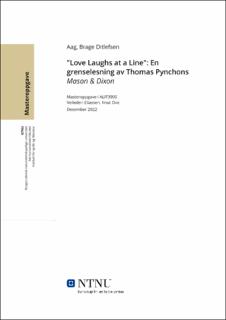| dc.contributor.advisor | Eliassen, Knut Ove | |
| dc.contributor.author | Aag, Brage Ditlefsen | |
| dc.date.accessioned | 2023-02-16T18:19:17Z | |
| dc.date.available | 2023-02-16T18:19:17Z | |
| dc.date.issued | 2022 | |
| dc.identifier | no.ntnu:inspera:124959251:21187715 | |
| dc.identifier.uri | https://hdl.handle.net/11250/3051740 | |
| dc.description.abstract | I denne masteroppgaven utforsker jeg Thomas Pynchons roman fra 1997, "Mason & Dixon" fra perspektivet av en "grensepoetikk". Jeg tar ampersanden i romanens tittel og Mason-Dixon-linjen som primære metaforiske figurer som tillater Pynchon å sammenveve en kompleks ordning av grensefigureringer på flere nivåer i teksten, noe som metter tekstens formelle, romlige og temporale konfigurasjoner med mening. Med Johan Schimanskis "grenselesningsteori" og metode, finner jeg at grenser på ulike plan (tekstlige, symbolske, temporale, topografiske og epistemologiske) korresponderer til hverandre slik at figureringene - og relasjonene dem imellom - får en betegnende funksjon. Grenser kan være både åpninger og barrierer, både portaler og vegger. Grenser både kobler sammen og deler opp. Avhandlingen vil vise at spillet og tvetydighetene i romanens grensekompleks gjenspeiler det Mannfred Kopp identifiserte som romanens "sentrale melding"; fellesskapet. | |
| dc.description.abstract | In this master’s thesis I explore Thomas Pynchon’s 1997 novel Mason & Dixon from the
perspective of a “border poetics”. I take the Ampersand on the novel’s cover page and the Mason-Dixon line as primary metaphorical figures, figures that allow Pynchon to weave together a
complex order of border figurations on multiple levels of story and text, endowing the novel’s
formal, spatial, and temporal configurations with meaning. With Johan Schimanskis theory and
method of border reading, I find that borders on different planes (textual, symbolic, temporal,
topographic, and epistemological) correspond with each other in such a way that the figurations
themselves, and their interrelations, make signification possible beyond levels of character, story,
and theme. Borders can either be openings or barriers, either portals or walls. Borders are both
devices of division and connectivity. Thus, I find that the interplay and ambiguity within the
novel’s border complex plays into what Mannfred Kopp identified as the novel’s “central
message”; togetherness | |
| dc.language | nob | |
| dc.publisher | NTNU | |
| dc.title | "Love Laughs at a Line": En grenselesning av Thomas Pynchon's Mason & Dixon | |
| dc.type | Master thesis | |
